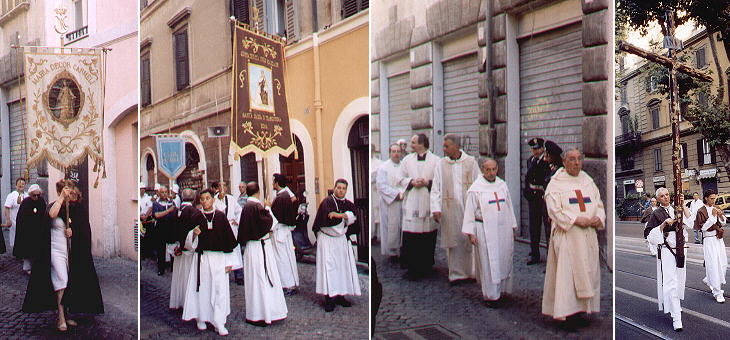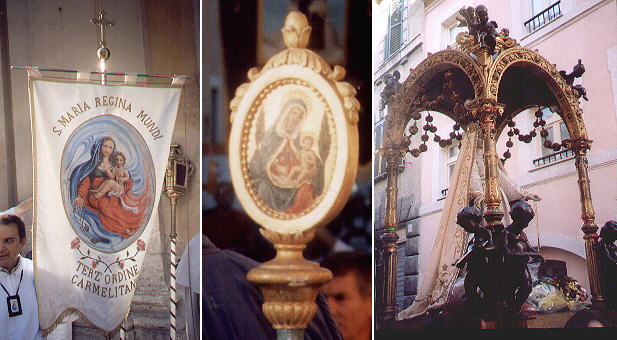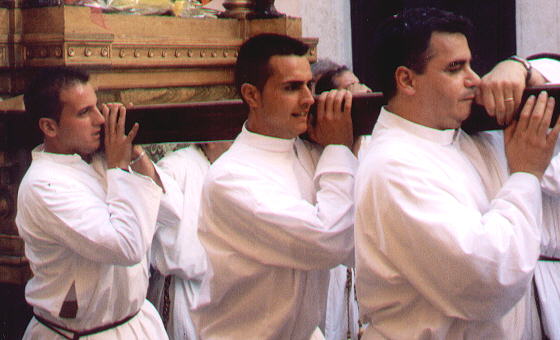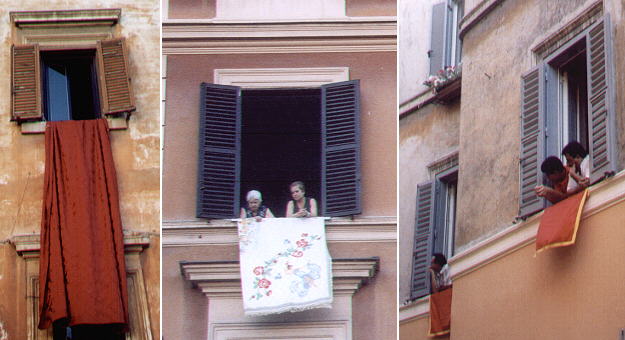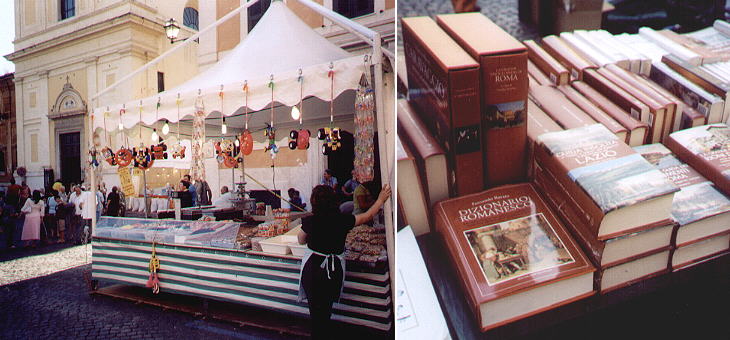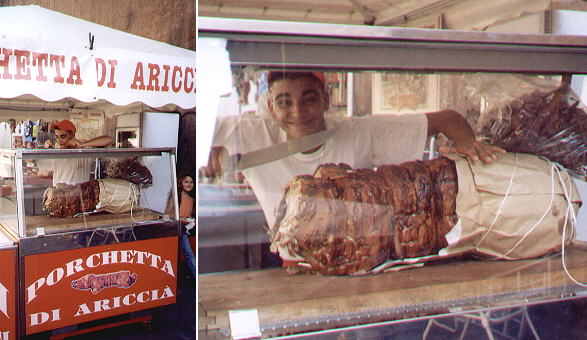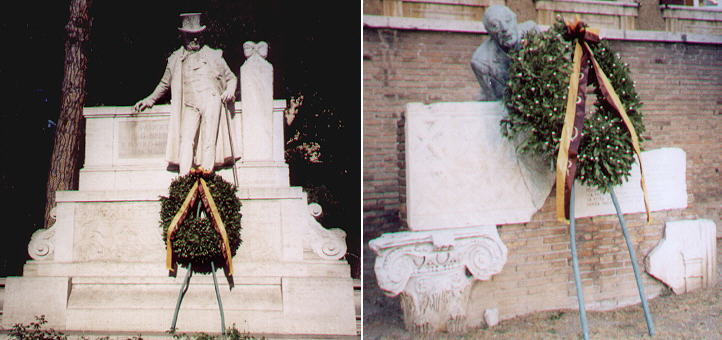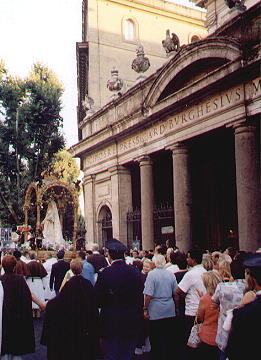

Days of Peace
(how to spend a peaceful day in Rome)
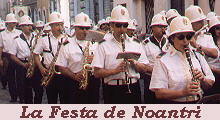 in Trastevere in Trastevere
"On the feast of Corpus Christi the long vestibules adjoining the colonnade of St. Peter's are adorned with tapestry hangings, copied from the cartoons of
Raphael and other eminent masters. The pillars of the colonnade, as well as the poles that support the awnings at the extremity of the piazza are
ornamented with wreaths of laurel, myrtle, etc.; and the Metropolis pours out its picturesque population
to witness the splendid and solemn spectacle.
The procession is superintended by the first Card. Deacon assisted by the Governor of Rome,
both seated at the entrance of the palace: it is directed by the Papal Master of ceremonies; and proceeds
in the following order. The youths of San Michele - The orphans of
S. Maria in Aquiro - The different religious and monastic Communities,
distinguished by their respective banners and costumes. The Roman Seminarists, in number about a hundred - Friars of the Order of Penance - Discalced
Augustinians - Cappuchins - Religious of the Order of Mercy - Jerolomite Friars - Minims -
Third Order of S. Francis - Minor Conventuals - Reformed Minors - Calced Augustininans - Carmelites -
Servites - Dominicans - Jerolomite Monks - Olivetan Benedictines - Camaldolese Benedictines -
Monte Cassino Benedictines - Regular Canons of the Lateran Congregation -
The Roman Seminarists, in number about a hundred - The fifty four city-parish priests wearing stoles and surplices - The Chapter
of the Illyrian church - Chapter of S. Anastasia - Chapter
of SS. Celsus and Julianus - Chapter of S. Angelo in Pescheria - Chapter
of S. Eustachius - Chapter of S. Maria in Via Lata -
Chapter of S. Nicola in Carcere - Chapter of S. Mark -
Chapter of S. Maria ad Martyres - Chamberlain of the Roman Clergy - Chapter
of S. Mary of Monte Santo - Chapter of S. Mary in Cosmedin -
Chapters of S. Mary in Trastevere and S. Lawrence in Damaso,
who walk together - Chapter of S. Mary Major's -
Chapter of S. Peter's - Chapter of S. John Lateran's -
The Viceregent of Rome with the members of his Tribunal - Camerieri (valets) d'onore di Spada e Cappa (dagger and cloak) -
Camerieri Segreti di Spada e Cappa - Procuratori di collegio - Confessor of the Pope's household, and
Apostolical Preacher - Bussolanti, Common and Secret Chaplains, who bear tiaras and Papal mitres -
Secret Chaplains - The Treasury - Advocate, with the Commissary of the R. C. A. - Consistorial Advocates
- Ecclesiastical Camerieri Segreti - The Pope's Choir - Referendaries of the Signature -
Abbreviators of the Parco Maggiore - Votanti (Jurors) della Segnatura di giustizia - Chierici di Camera -
Auditor of the Rota; and Master of the Sacred Palace - Two Secret Chaplains, one bearing the Pope's costly tiara, the other his costly mitre -
Maestro del S. Ospizio - Acolythe, who is a Votante di Segnatura, bearing a golden censor -
Subdeacon, who is an Auditor of the Rota, carrying the Cross; and seven Acolythes bearing wax lights,
near whom are two Ostiarii, called de Virga Rubea (red stick) - The twelve Penitentiaries of S. Peter's in Sacerdotal
vestments, preceded by Acolythes, bearing wands inserted in bunches of flowers - Abbots,
who are Generals of monastic Orders - Non- Assistant Bishops and Arch-bishops - Patriarchs -
The Cardinal-Deacons, Cardinal-Priests and Cardinal-Bishops - The Conservator - The Assistant Prince,
and the Governor of Rome - The Assistant Cardinal - Deacons, between whom walks the first Deacon -
The Master of ceremonies, and Thurifers (usually older youths) with golden censers, who immediately precede the B. Sacrament,
which is borne by the Pope under a stately canopy, alternatively supported by eight students
from the English, Irish and Scotch
colleges. The Pope, although apparently kneeling, is really seated in a sort of Curule chair, and is borne
on the shoulders of his Palafrenieri (footmen), dressed in liveries of scarlet silk. The Sovereign Pontiff is moreover surrounded by various
Prelates, Official attendants and guards; is flanked by two Ecclesiastical Camerieri Segreti, bearing
the flabelli (gigantic fans made with feathers); and followed by the Uditore della Camera; the Tesoriere Generale; the Maggiordomo; the Apostolic Protonotaries;
and the Generals and Procurators-General of various religious orders. Immediately behind follow
the different corps of Roman cavalry and infantry in their gala uniforms.
Having made the circuit of the piazza, the procession enters S. Peter's, the gilded ceiling of which
reflects the bright effulgence of the moving illumination beneath; and the triumphal ceremony
concludes with the Eucharistic Benediction, imparted to the adoring multitude, from the great altar, by the Father
of the Faithful, amid the clangour of military music, and the roar of artillery from the
castle of S. Angelo."
This somewhat confusing and enthusiast description is taken from a guide of Rome (Rome Ancient and Modern) written in 1842 by
the Very Reverend Jeremiah Donovan: the procession of Corpus Christi (or Corpus Domini) was just one
of the many processions taking place in Rome at that time: today only the procession of Good Friday at the
Colosseum can be compared with those of the past, although the ceremonial
is much streamlined and oriented towards spiritual aspects rather than pomp.
However a glimpse of the past can still be caught in the procession taking place in Trastevere on a Saturday in the second half of July.
Members of the brotherhoods following the cross
The procession is opened by a giant cross, which is followed by members of various brotherhoods, dressed in their
historical costumes and holding their banners (in the image above two Carmelitan brotherhoods and a group of Trinitarians).
Symbols of the brotherhoods and Madonna de Noantri
The procession celebrates the so called Madonna de Noantri (noantri is a dialectal word meaning noialtri, a strengthened
form of noi=we), a statue which is usually kept in S. Agata and which for the occasion is moved to a larger church,
S. Crisogono which is located very near S. Agata. For the occasion the statue is put on a highly decorated
(and very heavy) canopy. The statue was found in 1535 in the Tiber and it was brought to the Carmelitan friars of S. Crisogono: it was soon declared patroness of Trastevere and kept in a specially built
oratory opposite S. Crisogono. In 1890 the oratory was pulled down and the statue was moved to S. Agata.
The stress shows in the faces of the porters
To participate in bearing the canopy is regarded as a high honour, but it is not a light task. The porters have a cushion under the vest on the
shoulder bearing the weight. The procession lasts a couple of hours because the Madonna pays a visit (in a sort of socializing tour) to most of the
churches of Trastevere, rather than just crossing the street and going to S. Crisogono. The procession stops at each visited church and
the porters can have a little rest. The itinerary includes S. Maria della Luce, S. Giovanni Battista
dei Genovesi, S. Maria dell'Orto,
S. Francesco a Ripa and S. Pasquale.
Watching the procession from home
The image on the right shows a tapestry especially made for decorating a building during processions and
other festivities (the window belongs to the monastery next to S. Francesco a Ripa).
Private households decorate their windows in less formal ways.
Sweets and books about Rome on sale at the fair
The celebrations last eight days at the end of which the image of Madonna de Noantri is moved by another procession, which in part takes
place on the Tiber (in memory of the location where the statue was discovered), to S. Maria in Trastevere, the main church of the rione.
Do you fancy a slice of porchetta?
The attendance at the procession and during the following week at various events, mainly related to revamping Roman traditions,
is high and not limited to those living in Trastevere. Although its caloric contents is not suited to the July heat, nevertheless porchetta, the roasted baby pork, a typical product
of Ariccia, sells well.
The Roman poets Giuseppe Gioacchino Belli and Trilussa are honoured
Wreaths of laurels are laid at the monuments of two poets who wrote in Roman dialect and for the occasion some of their poems are read in public. I doubt however the following sonnet
by Giuseppe Gioacchino Belli
is ever included in the selection.
Santaccia de Piazza Montanara - II
A pproposito duncue de Santaccia
che ddiventava fica da ogni parte,
e ccoll'arma e ccor zanto e cco le bbraccia
t'ingabbiava l'uscelli a cquarte a cquarte;
è dda sapé cc'un giorno de gran caccia,
mentre lei stava assercitanno l'arte,
un burrinello co l'invidia in faccia
s'era messo a ggodessela in disparte.
Fra ttanti uscelli in ner vedé un alocco,
Oh, disse lei, e ttu non pianti maggio?
Bella mia, disse lui, nun ciò er bajocco.
E cqui Ssantaccia: alò, vvièccelo a mmette:
sscéjjete er buscio, e tte lo do in zoffraggio
de cuell'anime sante e bbenedette. |
Giuseppe Gioacchino Belli (1791-1863) wrote more than 2,000 sonnets which were published after his death. They depict, sometimes
in a very crude manner, the hypocrisy of the Roman society of the first half of the XIXth century. The sonnet quoted above
talks about an elderly prostitute
who does not charge her services to a penniless eager teenager, as a personal suffrage for the souls in Purgatory.
Trilussa (Carlo Alberto Salustri 1871-1950) portrayed the Italian society during the Fascist period, although in a more
subtle way, often using fable patterns to hide his satire.
All'ombra
Mentre me leggo er solito giornale
spaparacchiato all'ombra d'un pajaro,
vedo un porco e je dico:- Addio maiale! -
vedo un ciuccio e je dico:- Addio somaro! -
Forse 'ste bestie nun me capiranno,
ma provo armeno la soddisfazzione
de potè dì le cose come stanno
senza paura de finì in priggione. |
The short poem describes a man who loudly calls by their names a pig and a donkey; at least, he says, I have the satisfaction
to call things as they are without ending in jail.
The arrival of Madonna de Noantri at S. Crisogono
Other Days of Peace pages:
At the Flea Market
At the Beach
A visit to Roseto di Roma
Christmas in Rome
Eating Outdoors
A Sunny Day
Voicing Your Views and feeling better!
Finding Solace at the Protestant Cemetery

Go to my Home
Page on Baroque Rome or to my Home Page on Rome
in the footsteps of an XVIIIth century traveller.
|


 in Trastevere
in Trastevere
